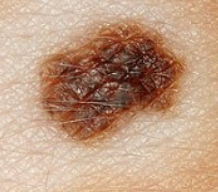
Do you have a mole of three shades that’s causing you a lot of anxiety because you know that melanoma can cause a mole to have more than two colors?
Perhaps you’ve seen images of melanoma and have noticed that usually you can count at least three shades of brown, or even three distinct different colors such as brown, black and grey.
What to Consider in a Mole of Three Shades
A mole of three shades of brown is less concerning than one of three actual colors such as tan, brownish-black and maroon.
“Yes, even if a mole has three shades, it can be benign,” says Vishal Madan, MD, consultant dermatologist, laser and skin cancer surgeon, and founder/director of Everything Skin Clinic™.
Dr. Madan explains, “However, if a mole which was previously a single shade, becomes two tone or three tone, this progression would be worrying.
“Color change should not be considered in isolation when making a diagnosis of melanoma. A history of change, dermoscopy features of melanoma are more important factors.”
Questions to Ask Yourself
• Has the mole always had three shades or three colors for as long as you can remember?
• If you began inspecting the mole only a few years ago, did it have the three color shades back then?
• Are the shades all within one color, such as shades of brown or shades of tan?
If you answered “Yes” to these three questions, this is reassuring. Here are more questions to consider:
• Did the mole used to have two or especially one color only?
• Has the mole gotten bigger over time?
• It the shape changing, e.g., it used to be rather circular, but now it’s looking lopsided or like an oval?
• Are the borders becoming increasingly jagged or erratic?
• Is it larger than the diameter of a pencil eraser?
• Does it bleed or crust over for no reason?
• Is the mole brand new, never there before?
If you answered “Yes” to any of these questions, have a dermatologist inspect the mole and then excise at least part of it for a biopsy.
If your mole of three shades turns out to be benign, or if you decide not to have it biopsied, you should at least inspect it every month (as with all of your other pigmented lesions) for any signs of melanoma.



























